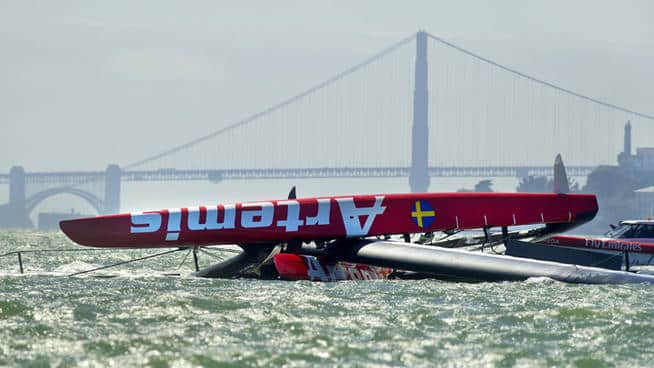
Wind limits at 34th America’s Cup
From an outside perspective, it seems like an absolute farce to cancel sailboat races on days that are best described as perfect. The best sailors racing aboard the world’s most sophisticated sailboats should be able to handle the same conditions that juniors tackle in their Optimists, no? Sadly, it’s not so simple.
The AC72-class catamaran was originally conceived as a yacht that could (and would) be raced in winds ranging from 3 knots to 33 knots, so as to reduce the odds of having to cancel race days because of too little wind (remember the 2007 Louis Vuitton Cup and the 32nd America’s Cup?), while also considering San Francisco’s breezy reputation. Everything changed on May 9, 2013, however, when Artemis Racing suffered catastrophic structural failure and capsized, trapping double-Olympic medalist Andrew “Bart” Simpson, age 36, underwater and ending one of sailing’s brightest careers.
An independent review panel, led by Regatta Director Iain Murray and populated by some of sailing’s most experienced minds, examined the situation and delivered a list of 37 safety recommendations aimed at mitigating risks. These were (eventually) accepted by the teams and the U.S. Coast Guard and were added as an amendment to the protocol governing the 34th America’s Cup. One of these items was a reduction in the maximum allowable wind speed, starting at 20 knots in July, increasing to 21 knots in August and then jumping to 23 knots in September. Complicating matters even more, these wind limits are also affected by the tide, with a strong ebb tide—such as the one running this week—lowering the acceptable limits. The wind limits go into effect 15 minutes before the start of each race and are enforced until the first boat rounds the windward mark at the end of leg three.
Frustratingly, the Race Committee has canceled three of the past five races because of too much breeze; worse still, Saturday’s second race was called off just minutes before the two teams would have completed the third leg, even though both Oracle Team USA and Emirates Team New Zealand (ETNZ) were clearly capable of continuing.
So why not simply change the wind limits? In theory, Oracle and ETNZ could both agree to a change, the Coast Guard could again be consulted and the limitations could possibly be edited, but this isn’t a call that the Race Committee can independently execute. Also, this being the America’s Cup, both teams are acutely aware of their strengths and struggles, and neither team is interested in giving away even the slightest advantage.
According to the latest reports, Oracle proposed raising the limit from 23 to 24 knots today, but ETNZ declined, saying that it’s too deep into the regatta cycle to make changes. Whether this means that Oracle is the faster heavy-air boat remains unknown, but for fans it’s downright lame to watch the world’s best head in while countless local windsurfers and Laser sailors are rushing to head out.
Racing is scheduled to resume tomorrow at 1315 hours in San Francisco, so please stay tuned for the latest news, as it breaks.









